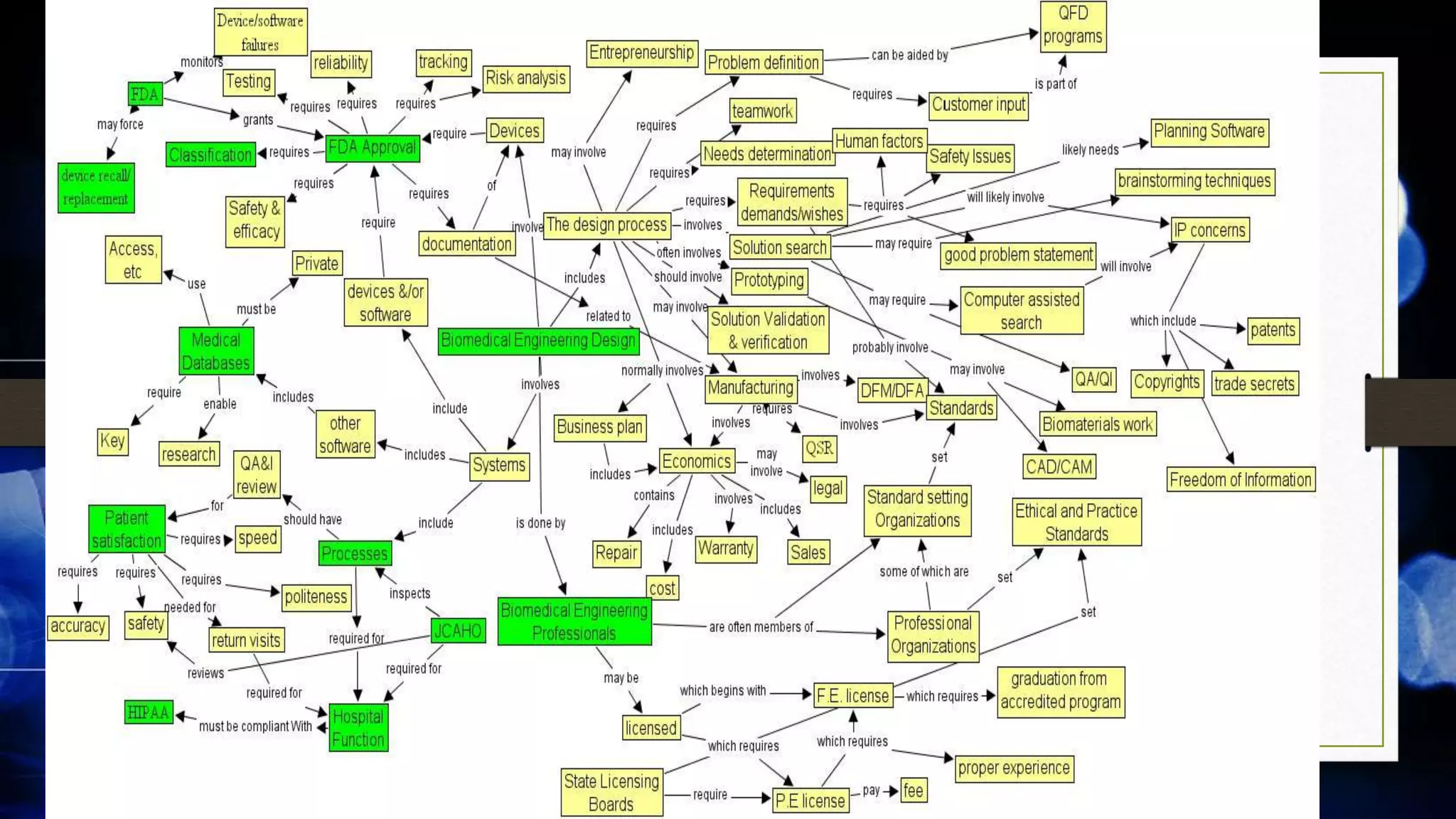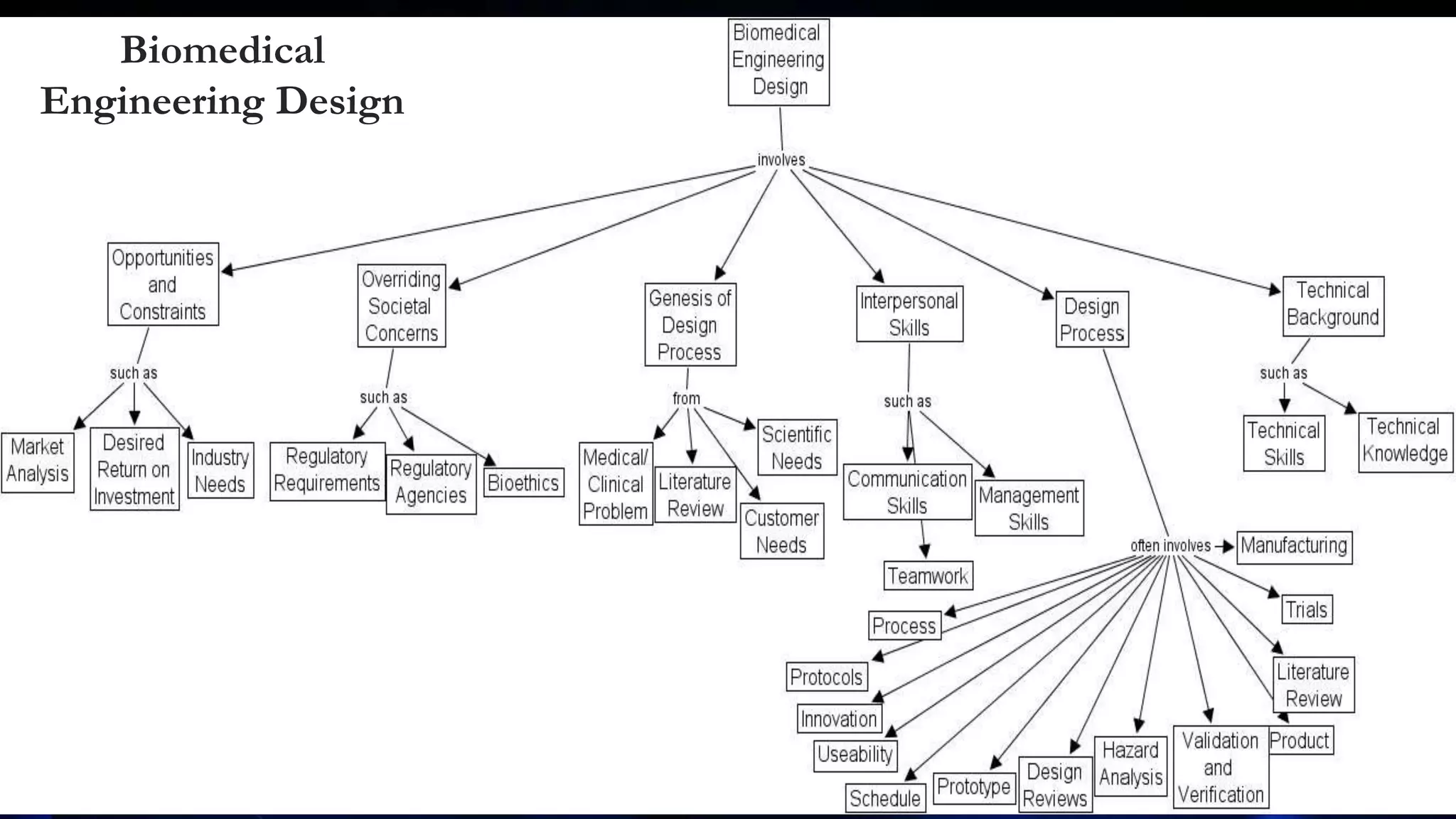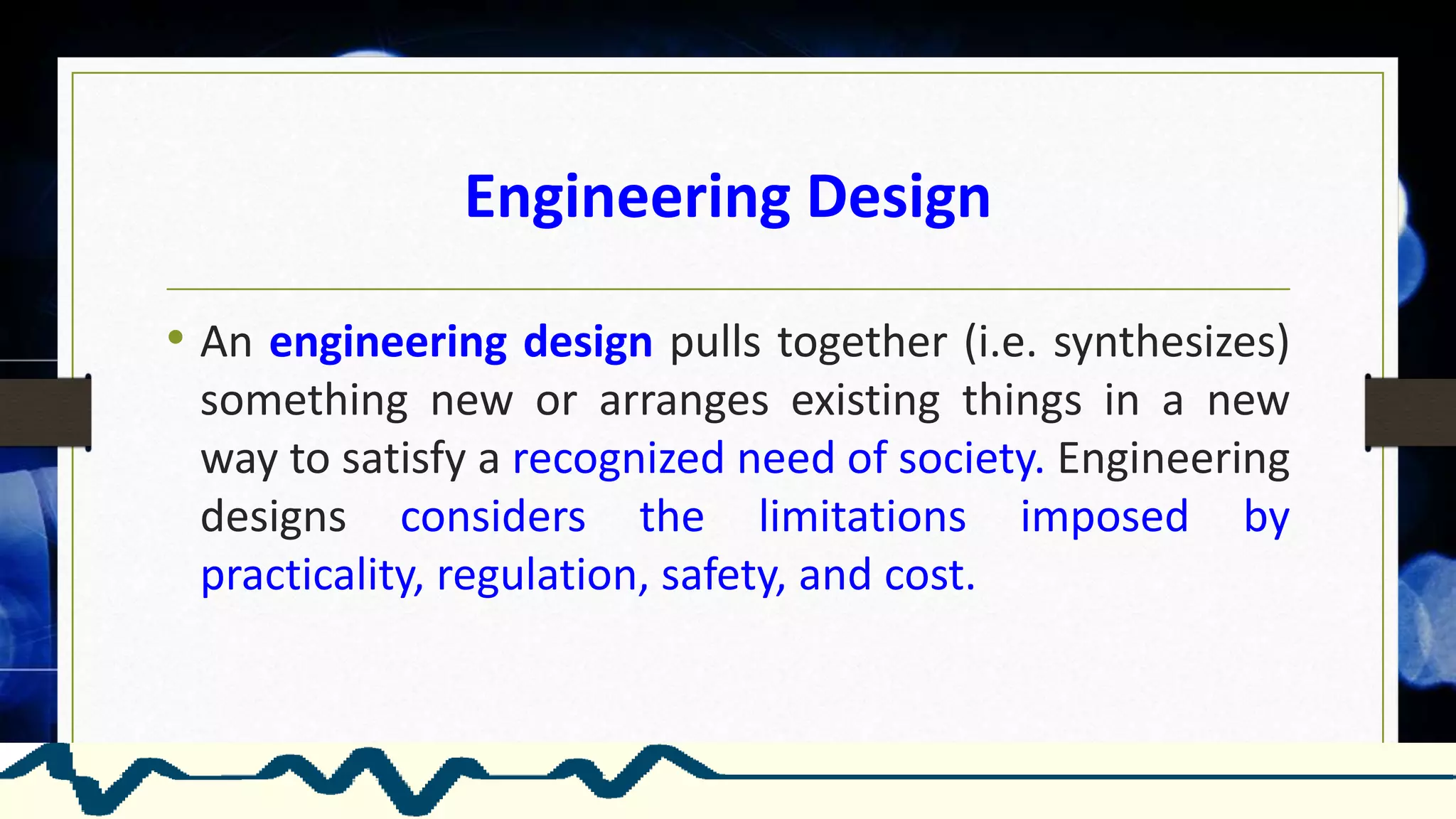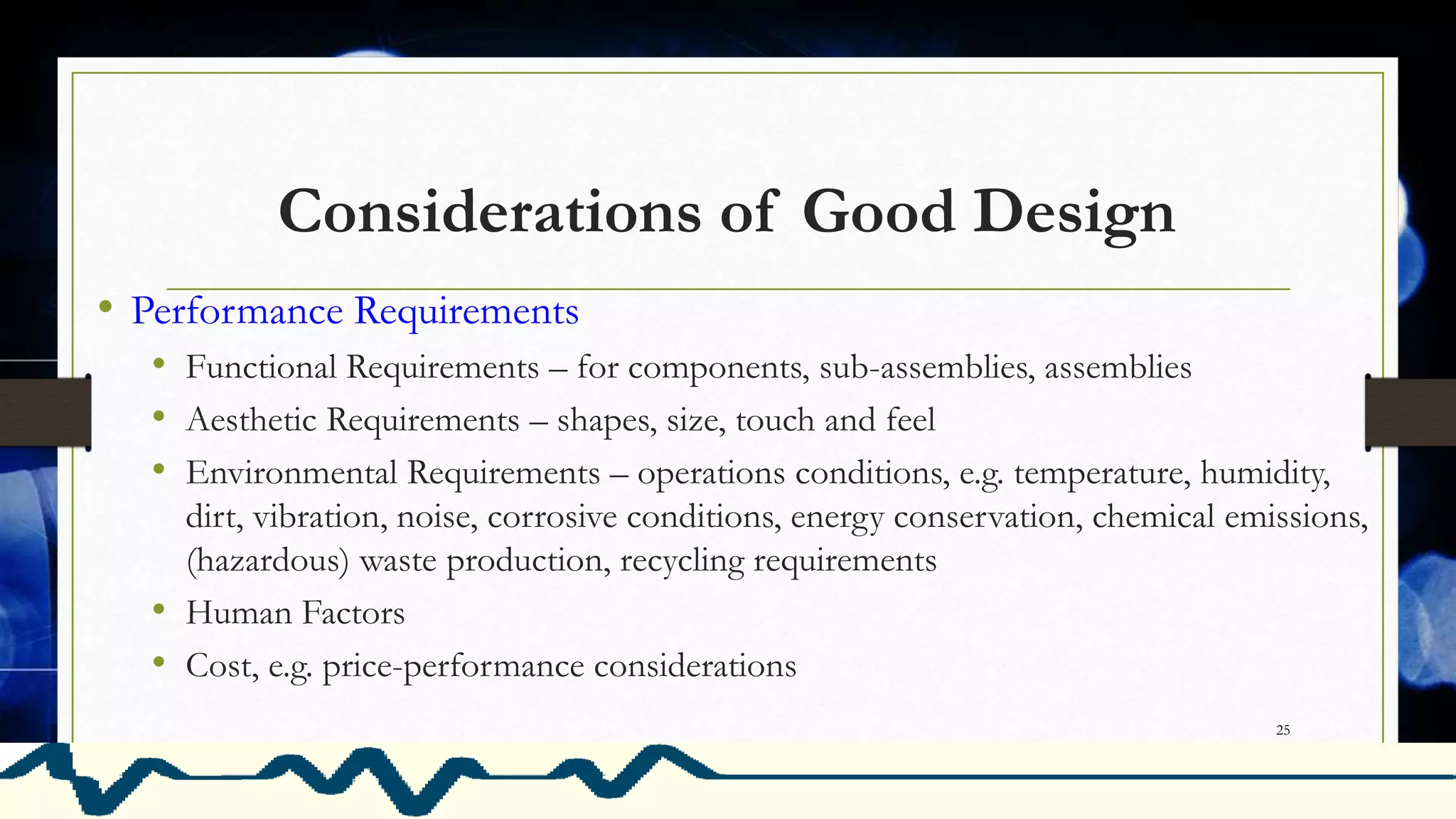The document provides an overview of biomedical engineering design and related topics presented at Mbarara University of Science and Technology. It discusses what engineering design entails, the engineering design process, considerations for good design such as requirements and regulations. It also covers topics like prototyping, testing, human factors, intellectual property, and engineering ethics.















![Importance of Engineering Design
1. Design costs very little in terms of
the overall product cost but its
decisions has major event on the
overall cost
2. Defects introduced in the design
phase cannot be compensated in
the manufacturing phase
3. Design process should be
conducted to develop quality, cost-
competitive products in the
shortest time possible
16
[Source: Dieter & Schmidt 2013]](https://image.slidesharecdn.com/biomedicalengineeringdesignbrianmust-190708144041/75/Biomedical-engineering-design-16-2048.jpg)

![Iterative Engineering Design Process
• Complex systems can be decomposed into a sequence of design processes
• Iteration repeated trials
• Gives opportunity to improve design on basis of preceding outcome
• More knowledgeable team may arrive at acceptable solutions faster
• Requires high tolerance of failure
• Requires determination to persevere and work out the problem
• Often involve tradeoffs and arrive at near-optimal solutions
18[Source: Asimov 1962]](https://image.slidesharecdn.com/biomedicalengineeringdesignbrianmust-190708144041/75/Biomedical-engineering-design-18-2048.jpg)





![Problem-solving Methodology for
Engineering Design …
• Paradox
• Design knowledge grows as
design freedom diminishes
24
[Source: Dieter & Schmidt 2013]](https://image.slidesharecdn.com/biomedicalengineeringdesignbrianmust-190708144041/75/Biomedical-engineering-design-24-2048.jpg)






![Engineering Project Management …
• Initial planning crucial
• NASA Rule # 15: a review of most failed project problems indicates that the disasters were well-
planned to happen from the start. The seeds of the problem were laid down early. Initial planning is
most vital [Madden, 100 Rules of NASA Project Managers]
• Project economics, e.g. NASA’s study of software development projects show that the cost of fixing
a defect increases:
• fixing at design phase
• fixing at coding phase (10x)
• fixing at testing phase (100x)
• Lesson
• Invest sufficient planning time and effort early because the cost savings are huge 31](https://image.slidesharecdn.com/biomedicalengineeringdesignbrianmust-190708144041/75/Biomedical-engineering-design-31-2048.jpg)




![Integration
36
[Source: Schmidt 2009]](https://image.slidesharecdn.com/biomedicalengineeringdesignbrianmust-190708144041/75/Biomedical-engineering-design-36-2048.jpg)


![Example: Saving the World
God’s memo:
Noah, I have decided to make it rain for 40 days
and 40 nights. I want you to build a big ark to
hold a pair of all animals on earth, and people, so
you can survive the flood. After the flood, you can
restore life on earth and ensure the long-term
survival of human and animal life. Get everything
ready before the big rain starts in six months. 39
[Source: Schmidt 2009]](https://image.slidesharecdn.com/biomedicalengineeringdesignbrianmust-190708144041/75/Biomedical-engineering-design-39-2048.jpg)
![Noah’s Ark Project Management
[Source: Schmidt 2009]
40](https://image.slidesharecdn.com/biomedicalengineeringdesignbrianmust-190708144041/75/Biomedical-engineering-design-40-2048.jpg)
![Noah’s Ark Project Inputs
41
[Source: Schmidt 2009]](https://image.slidesharecdn.com/biomedicalengineeringdesignbrianmust-190708144041/75/Biomedical-engineering-design-41-2048.jpg)
![Noah’s Ark Project Resource Budget Details
42
[Source: Schmidt 2009]](https://image.slidesharecdn.com/biomedicalengineeringdesignbrianmust-190708144041/75/Biomedical-engineering-design-42-2048.jpg)
![Team Responsibility and Communication
• The Confused Project Team
• Four people named Everybody, Somebody, Anybody and Nobody worked together.
• An important Outcome needed managing, and Everybody was sure that Somebody would do it.
• Anybody could have done it, but Nobody actually did it.
• Somebody got angry because it was really Everybody’s job.
• Everybody thought that Anybody could do it, but Nobody realized that Somebody
wouldn’t.
• As it turned out, Everybody blamed Somebody when Nobody did what Anybody could have done!
43
[Source: Schmidt 2009]](https://image.slidesharecdn.com/biomedicalengineeringdesignbrianmust-190708144041/75/Biomedical-engineering-design-43-2048.jpg)
![Noah’s Ark Responsibility Chart
R: Responsible (may delegate), P: Participants, C: may be Consulted, A: Approves, I: must be informed
44
[Source: Schmidt 2009]](https://image.slidesharecdn.com/biomedicalengineeringdesignbrianmust-190708144041/75/Biomedical-engineering-design-44-2048.jpg)

![• Order of the Engineer: association for graduate and professional engineers in
North America emphasizing the pride and responsibility in the engineering
profession
• Code of ethics called The Obligations of an Engineer
• The Engineer’s Ring
46
[Source: Wikipedia]
Engineering Ethics](https://image.slidesharecdn.com/biomedicalengineeringdesignbrianmust-190708144041/75/Biomedical-engineering-design-46-2048.jpg)


































![Patents
• The law (Patents Act, Cap 216) defines [Patents Act, S.8 (1)] an
invention as a solution to a specified technological problem,
which may be or may relate to a product or process. However the
following are not inventions: [Patents Act, S.8 (2) (a)]
(a) Discoveries and scientific and mathematical theories;
(b) Plant/animal varieties or biological processes for the production of: plants, animals
(c) Schemes, rules or methods for doing business performing purely mental acts or playing
games;
(d) Methods of treatment of the human animal body;
(e) Mere presentation of information.](https://image.slidesharecdn.com/biomedicalengineeringdesignbrianmust-190708144041/75/Biomedical-engineering-design-81-2048.jpg)










